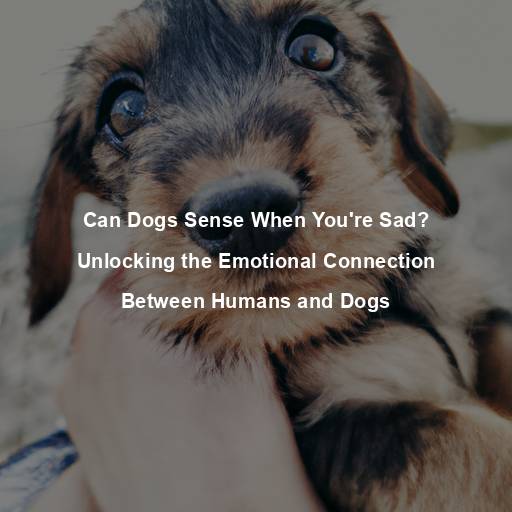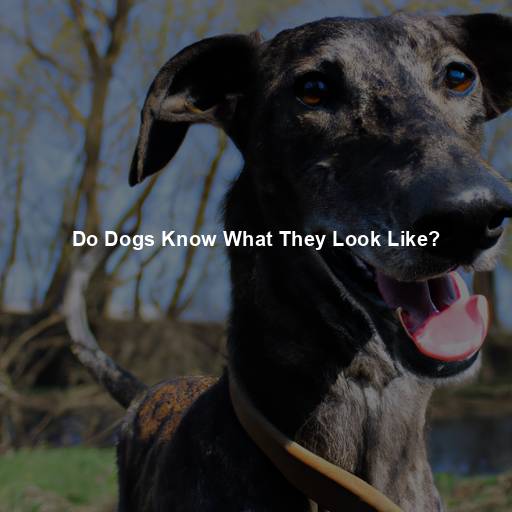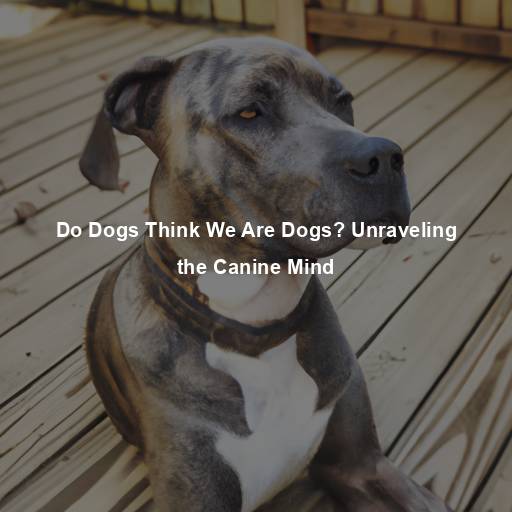Can Dogs Sense When You’re Sad? Unlocking the Emotional Connection Between Humans and Dogs
Last Updated on November 24, 2023 by Evan
Contents
- 1 Understanding the Emotional Intelligence of Dogs
- 1.1 The Language of Emotions
- 1.2 Reading Your Body Language
- 1.3 The Power of Scent
- 1.4 Empathy: The Key to the Canine Heart
- 1.5 Scientific Studies on Canine Emotional Intelligence
- 1.6 The Role of Oxytocin
- 1.7 The Power of Unconditional Love
- 1.8 Nurturing the Bond
- 1.9 The Human-Dog Emotional Connection: A Source of Comfort and Healing
- 1.10 Dogs as Emotional Support Animals
- 1.11 The Healing Power of Canine Companionship
- 1.12 Dogs in Therapy Settings
- 1.13 Canine-Assisted Therapy
- 1.14 Dogs in Trauma Recovery
- 1.15 The Unique Connection Between Humans and Dogs
- 1.16 Celebrating the Canine-Human Connection
- 1.17 The Canine Sense of Smell
- 1.18 The Role of Hormones
- 1.19 Can Dogs Empathize with Human Emotions?
- 1.20 The Role of Socialization
- 1.21 Individual Differences in Canine Emotional Intelligence
- 1.22 The Power of Positive Reinforcement
- 1.23 The Mutual Benefits of the Human-Dog Emotional Connection
- 1.24 Unlocking the Mysteries of Canine Emotional Intelligence
- 2 FAQs – Does dogs know when you are sad?
- 2.1 Do dogs have the ability to sense if someone is sad?
- 2.2 How can dogs tell if their owners are sad?
- 2.3 Are there any behavioral signs that indicate a dog knows when someone is sad?
- 2.4 Why do dogs react to someone’s sadness?
- 2.5 Can dogs help alleviate sadness?
- 2.6 Are all dogs equally capable of sensing sadness?
Understanding the Emotional Intelligence of Dogs
Dogs have long been hailed as man’s best friend, and for good reason. Their unwavering loyalty, unconditional love, and intuitive nature make them remarkable companions. But have you ever wondered if dogs can actually sense when you’re feeling down or sad? It’s a question that has fascinated pet owners and researchers alike.
The Language of Emotions
In a realm where words fail, dogs excel. Without the gift of speech, their mastery lies in the intricacies of non-verbal communication, a language of gestures and expressions. With a keen eye for detail, they effortlessly decode the subtleties in our actions, the shifts in our voice, and the stories hidden within our faces. This profound sense enables them to navigate the labyrinth of our emotions, providing a tailored response to match our nuanced states.
Reading Your Body Language
Have you ever noticed how your dog seems to just know when something’s wrong? It’s almost uncanny how they can read your body language and pick up on your emotions. Dogs are like little detectives, decoding the subtle cues in your posture, facial expressions, and mannerisms. When you’re feeling down, they might see your slump, the slight droop in your face, and the change in how you move.
The Power of Scent
A dog’s sense of smell is nothing short of extraordinary. They possess up to 300 million olfactory receptors, compared to our mere 6 million. This incredible sense of smell allows them to detect subtle changes in our body odor that occur when we experience different emotions. When we’re sad, our body chemistry changes, and our scent alters.
Empathy: The Key to the Canine Heart
One of the most remarkable aspects of canine emotional intelligence is their capacity for empathy. Dogs have an uncanny ability to mirror our emotions and respond accordingly. When they sense that we’re sad, they often exhibit behaviors that aim to comfort and console us. They may nuzzle closer, offer a gentle paw, or simply sit quietly by our side.
Scientific Studies on Canine Emotional Intelligence
Explorations into the intricate realm of canine emotional intelligence have sparked enchanting scientific inquiries. Scientists, driven by an insatiable curiosity, have embarked upon a multifaceted journey to decipher the enigmatic depths of dogs’ intuitive prowess. Among the treasure trove of discoveries lies a captivating study from the esteemed corridors of the University of Vienna – a testament to their relentless pursuit. This enlightening research revealed that our furry companions possess a primitive ability to discern the contrasting hues of joy and fury etched upon human countenances, hinting at a rudimentary form of facial recognition entwined within their mysterious repertoire.
The Role of Oxytocin
Oxytocin, often referred to as the “love hormone,” is released in both humans and dogs during moments of bonding and affection. This hormone plays a significant role in nurturing social connections and fostering emotional bonds. Research has shown that interacting with dogs can increase oxytocin levels in both humans and canines, further strengthening the emotional connection between the two species. This chemical bond may explain why dogs are so attuned to our emotional well-being.
The Power of Unconditional Love
The boundless compassion and empathy displayed by our canine companions transcend comprehension, as their inherent ability to perceive our emotional distress only scratches the surface of their remarkable qualities. Free from the confines of judgment or the need for justification, dogs generously bestow unwavering devotion upon us, serving as constants in a world that often appears bewildering. Their unwavering loyalty and unspoken understanding provide us with an invaluable source of solace, their presence alone possessing the power to ease our burdens in the depths of despair. Far more than mere pets, dogs seamlessly integrate themselves within the tapestry of our existence, assuming integral roles within our intricate emotional support systems.
Nurturing the Bond
Discovering the true essence of companionship with our beloved pets can be an enigmatic journey. In order to forge a deeper, more profound connection, a myriad of avenues unveil themselves – a beautiful tapestry of possibilities. Whether it be through engaging in shared experiences, deciphering the language of unconditional love or unraveling the secrets of mutual understanding, the path towards strengthening the emotional bond with our furry confidants is one that brims with excited anticipation and endless enchantment.
There’s no denying that our furry friends cherish our company like nothing else. Whether it’s going for invigorating walks, engaging in playful frolics, or simply snuggling up on the couch, dedicating regular quality time entwines our hearts and strengthens the emotional rapport we share with our beloved pups.
When it comes to shaping your furry friend’s behavior, a little positivity can go a long way. By using the power of praise and rewards, you can teach your dog to associate your presence with pure joy. Embrace the art of positive reinforcement to encourage desirable actions and create a harmonious bond filled with happiness and a sense of security. It’s all about fostering an environment where your pup thrives, leaving you both bursting with delight and wonder.
When it comes to our furry friends, it’s essential that we tune in to their needs with unwavering attention. From providing them with a cozy home to nourishing their bodies with a well-rounded diet, ensuring their well-being should be our top priority. Let’s not forget the importance of exercise and mental stimulation, as a fulfilled pup is more likely to forge a strong emotional bond with their human counterpart.
- Seek Professional Help if Needed: If you notice significant changes in your dog’s behavior or suspect they may be experiencing emotional distress, don’t hesitate to seek professional help. A veterinarian or animal behaviorist can provide guidance and support to ensure your dog’s emotional well-being.
The Human-Dog Emotional Connection: A Source of Comfort and Healing
In times of sadness or distress, the presence of a loving and empathetic dog can be incredibly therapeutic. Dogs have an innate ability to provide comfort and healing, offering a shoulder to lean on when we need it most. Their unwavering loyalty and unconditional love remind us that we are never alone in our journey through life.
So, the next time you find yourself feeling sad, take a moment to appreciate the intuitive nature of dogs. They may not have the ability to understand every nuance of human emotions, but they possess an extraordinary capacity to sense our sadness and offer solace in their own unique way. The emotional connection between humans and dogs is a truly remarkable and cherished bond that continues to inspire and enrich our lives. ## The Therapeutic Role of Dogs in Emotional Support
Dogs as Emotional Support Animals
Beyond their innate ability to sense and respond to human emotions, dogs have also been recognized for their role as emotional support animals. These specially trained dogs provide comfort and companionship to individuals experiencing emotional or psychological difficulties. Whether it’s helping someone overcome anxiety, providing solace to those suffering from PTSD, or offering a sense of calm to individuals with autism, emotional support dogs play a crucial role in improving mental well-being.
The Healing Power of Canine Companionship
There’s something magical about the way dogs can light up our lives and bring an unexpected dose of joy and calm. Recent studies have taken a closer look at these four-legged wonders and uncovered a fascinating connection between their wagging tails and our overall well-being. The evidence is just pouring in – spending time with a furry friend can work wonders for our stress levels, making our blood pressure drop and leaving us with a lasting sense of contentment. It turns out that the simple act of petting a dog unlocks a floodgate of endorphins, those marvelous hormones that have been secretly whispering “feel-good” to our bodies all along.
Dogs in Therapy Settings
In a world full of uncertainties, therapy dogs emerge as divine messengers of solace, their furry paws spreading comfort like a magic elixir. These extraordinary canines traverse the corridors of hospitals, nursing homes, and schools, sprinkling joy and healing balm on weary souls in need. With their tails wagging like rhythmic metronomes of joy, therapy dogs instill a sense of calm, unraveling the knots of anxiety, and illuminating the darkest corners with a radiant glimmer of hope. In a realm where pain and distress loom large, these four-legged angels embody unconditional love, weaving a protective cocoon that shields against the harsh winds of judgment and prejudice.
Canine-Assisted Therapy
In today’s fast-paced and ever-evolving world, it’s no surprise that alternative therapies are grabbing attention like never before. Canine-assisted therapy, a fascinating modality also referred to as animal-assisted therapy, has taken the therapeutic landscape by storm. Whether in adrenalin-charged hospitals, nurturing rehabilitation centers, or serene mental health clinics, the incorporation of dogs into treatment processes has proven to be remarkably influential. These four-legged therapists have an uncanny ability to foster a positive and encouraging atmosphere, amplify communication and social connections, and ignite profound emotional healing and personal development.
Dogs in Trauma Recovery
For individuals who have experienced trauma, the presence of a dog can be particularly beneficial. Dogs offer a sense of security and trust, providing a safe space for individuals to process their emotions and memories. They can help reduce anxiety and hypervigilance, and their calming presence can assist in grounding individuals during moments of distress. Dogs in trauma recovery settings are often trained to provide deep pressure therapy, where they apply gentle pressure to specific areas of the body, helping individuals feel calm and secure.
The Unique Connection Between Humans and Dogs
There’s something truly magical about the connection we share with our four-legged friends. It’s a dynamic that transcends words, rooted in a deep sense of trust, affection, and empathy. Our dogs seem to have some sort of sixth sense when it comes to understanding our emotions, offering solace and unwavering support to help us navigate life’s ups and downs. And the beauty of it all?
Celebrating the Canine-Human Connection
Delving further into the intricate world of canine emotional intelligence and the profound influence our four-legged companions have on our emotional state, it becomes imperative to honor and treasure the inexplicable bond forged between humans and dogs. From the rhythmic swaying of their tails to the tender nudges and profound gazes they bestow upon us, dogs possess an innate ability to penetrate the depths of our hearts, serving as a poignant reminder of the sheer magnificence and unwavering strength inherent in the human essence.
So, the next time you find yourself feeling sad or in need of emotional support, remember the incredible bond between humans and dogs. Reach out to your furry friend, seek solace in their presence, and allow their unconditional love to heal and uplift your spirit. Dogs truly are remarkable creatures, and their ability to sense and respond to our emotions is a testament to the extraordinary connection we share with them. ## Exploring the Science Behind Dogs’ Ability to Sense Human Emotions
The Canine Sense of Smell
Dogs possess a remarkable sense of smell, which plays a significant role in their ability to detect and respond to human emotions. Their olfactory system is highly developed, allowing them to detect subtle changes in our body odor that occur when we experience different emotions. Research has shown that dogs can distinguish between the scents of happy and fearful humans, further highlighting their olfactory prowess.
The Role of Hormones
Hormones play a crucial role in regulating emotions, and dogs’ ability to sense these hormonal changes contributes to their understanding of our emotional state. For example, when we’re sad or stressed, our bodies release cortisol, a stress hormone that dogs can detect through their acute sense of smell. This ability to sense hormonal changes provides dogs with valuable information about our emotional well-being.
Can Dogs Empathize with Human Emotions?
We’ve long known that empathy is one of those uniquely human qualities that sets us apart from the animal kingdom. But hold onto your hats, folks, because a groundbreaking study conducted at the University of London has turned this belief on its furry little head. Brace yourselves, dog lovers, because it turns out that our canine companions may just have a hidden talent for empathy. Yep, you read that right.
The Role of Socialization
Socialization plays a vital role in shaping a dog’s emotional intelligence. Dogs that have been properly socialized from a young age are more likely to be attuned to human emotions and respond empathetically. Through positive experiences and interactions with humans, dogs develop a deeper understanding of our emotional cues and become more skilled at interpreting and responding to them.
Individual Differences in Canine Emotional Intelligence
While dogs, as a species, possess a remarkable ability to sense human emotions, it’s important to acknowledge that there are individual differences in canine emotional intelligence. Just like humans, some dogs may be more naturally empathetic or attuned to emotions, while others may require more training and socialization to develop these skills. Factors such as breed, upbringing, and individual personality traits can all influence a dog’s emotional intelligence.
The Power of Positive Reinforcement
Understanding and connecting with our furry friends on a deeper level has always fascinated researchers and dog lovers alike. It turns out that positive reinforcement training techniques can be a game-changer in honing a dog’s emotional intelligence and their knack for sensing and responding to human emotions. By showering them with rewards for showcasing empathetic behaviors, like comforting a grieving owner, we can pave the way for a heartwarming bond and foster the growth of empathetic qualities within our four-legged companions. It’s incredible how simple gestures can have such a profound impact!
The Mutual Benefits of the Human-Dog Emotional Connection
While dogs’ ability to sense human emotions is undoubtedly beneficial for us, the emotional connection we share with dogs is a mutually beneficial one. Dogs thrive on companionship and human interaction, and the bond they form with their human companions provides them with a sense of purpose, security, and love. The emotional connection between humans and dogs is a reciprocal one, as both parties derive comfort, joy, and a sense of fulfillment from the relationship.
Unlocking the Mysteries of Canine Emotional Intelligence
As the bond between humans and dogs grows stronger, the veil of mystery surrounding canine emotional intelligence is being lifted, revealing a fascinating realm of understanding. Delving into the depths of this intricate connection, scientists are unraveling the enigmatic neural pathways that underlie dogs’ uncanny ability to sense and respond to human emotions. This captivating journey of exploration also leads researchers to question the role that genetics plays in shaping the emotional intelligence of our four-legged friends, adding yet another layer of complexity to this ever-evolving field of study.
The more we learn about dogs’ emotional intelligence, the better equipped we become to nurture and strengthen the emotional connection between humans and our loyal canine companions. It is through this understanding that we can continue to celebrate the incredible bond we share with dogs, one that transcends words and touches the very essence of our souls.
In moments of melancholy or longing for compassion, it is a true solace to know that our cherished canines possess an innate understanding of our emotional states. Let us wholeheartedly embrace the solace they provide, treasuring the profound bond that intertwines our very beings. Their remarkable ability to perceive and connect with our sentiments never ceases to amaze and invigorate our souls.
FAQs – Does dogs know when you are sad?
Do dogs have the ability to sense if someone is sad?
It’s truly fascinating how dogs possess this innate gift to intuitively detect sadness in people. Their heightened sensitivity towards human emotions allows them to effortlessly decipher subtle shifts in facial expressions, tone of voice, and body language. It’s as if they have a sixth sense that enables them to perceive the emotional state of their owners, unraveling the hidden sorrow that may be concealed. This remarkable ability of our canine companions to empathize with our emotions is just one of the many reasons why they hold such a special place in our hearts.
How can dogs tell if their owners are sad?
Dogs can sense if their owners are sad through various means. They primarily rely on their acute sense of smell, which allows them to detect chemical changes in human perspiration associated with stress and sadness. Additionally, dogs can interpret changes in facial expressions and body language, as well as the tone and pitch of their owner’s voice. They may also rely on their strong bond with their owners, as they are highly attuned to their emotions and behaviors through observation.
Are there any behavioral signs that indicate a dog knows when someone is sad?
It’s no secret that our furry friends, dogs, possess an uncanny ability to pick up on our emotions. Have you ever noticed that when you’re feeling blue, your loyal companion cuddles up to you, showering you with comforting licks and snuggles? It’s as if they instinctively know how to provide solace in times of distress. Furthermore, their empathetic nature shines through as they become more attuned to our needs, offering a gentle ear to lean on or a nudge for reassurance. And let’s not forget how they effortlessly bring a spark of joy back into our lives with their playful antics or by eagerly presenting us with a favorite toy. In a world full of perplexity, the bond between humans and dogs remains a beacon of unwavering support and unconditional love.
Why do dogs react to someone’s sadness?
When it comes to the intricate world of canine emotions, it seems that dogs have an inexplicable knack for picking up on our deepest sorrows. With their sociable nature and uncanny ability to form deep emotional bonds, they have evolved over millennia to become master interpreters of human feelings. Through some mysterious blend of instinct and intuition, they are attuned to our every emotional fluctuation, stepping up to the plate as natural-born comforters whenever we’re down. Their compassion-driven behavior stems from a place of intrinsic empathy, driven by an unwavering desire to ease the burdens of their beloved owners.
Can dogs help alleviate sadness?
Absolutely! Dogs have been shown to provide significant emotional support and help alleviate sadness in humans. Being in the presence of a dog can increase the production of oxytocin and serotonin, commonly referred to as the “feel-good” hormones, which can enhance mood and reduce stress. Furthermore, petting or cuddling a dog can promote relaxation and provide comfort during difficult times. Dogs can also serve as wonderful companions, offering unconditional love and loyalty, which can have a positive impact on a person’s overall emotional well-being.
Are all dogs equally capable of sensing sadness?
Dogs, those fascinating creatures that share our lives, have a mysterious knack for tapping into our emotional realms. Yet, not all dogs are equal in this uncanny ability to perceive and empathize with our sadness. It all boils down to a complex interplay of their breed, temperament, and life experiences, shaping their individual sensitivity levels. Elements like training, social interactions, and the strength of the human-canine bond can also shape how well a dog picks up on our melancholy vibes. However, one thing remains crystal clear: our four-legged companions, irrespective of their backgrounds, possess an extraordinary potential to bring comfort and solace during our darkest moments.






